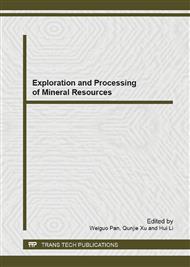[1]
PAYNE M L. Critical technologies for success in extended-reach drilling[R]. SPE 28293, (1994).
Google Scholar
[2]
Jianguo Zhang. etc. Oil Drilling &Production Technology. Vol. 20 (6) (1998), P, 6-10 (In Chinese).
Google Scholar
[3]
Minghui Lu, Zhichuan Guan. Vol. 31 (5) (2003), P, 70-71 (In Chinese).
Google Scholar
[4]
Leliang Chen. Drilling & Production Technology. Vol. 17 (1) (1994), P, 6-8 (In Chinese).
Google Scholar
[5]
Xingyou Zhou. Petroleum Industry Technical Supervision. Vol. 19 (8) (2003), P 4-5 (In Chinese).
Google Scholar
[6]
Tinggen Chen, Zhichuan Guan. Drilling engineering theory and technology [M]. China Petroleum University Press. Dongying, Shandong (2006).
Google Scholar
[7]
Yinao Su, Xiurong Dou, Jiajin Wang. Oil Drilling &Production Technology. Vol. 27 (2) (2005), P, 78-80 (In Chinese).
Google Scholar
[8]
N.B. Moore, P.W. Mock, R.E. Krueger. Reduction of drill string torque and casing wear in extended-reach wells using non-rotating drill pipe protectors [R]. SPE 35666 (1996).
DOI: 10.2118/35666-ms
Google Scholar
[9]
Tim Parker Long,et al. Inaccessible drilling targets and completions operation made possible by the alleviation of excessive torque and drag. SPE 125991 (2009).
DOI: 10.2118/125991-ms
Google Scholar
[10]
Wang Zhongsheng, Jiao Kangni, Xiang Weiwei, The People's Republic of China. Patent CN 101117884. (2007).
Google Scholar
[11]
Kjell-Inge Sola,Bjrnar Lund. Newdownhole tool for coiled tubing extendedreach[R]. SPE 60701 (2000).
Google Scholar
[12]
Zhiqing Yu. Drilling & Production Technology. Vol. 22 (1) (1999) , P, 66-67 (In Chinese).
Google Scholar
[13]
McCarthy A M,Stanes B H,Clark A W,et al. A step change in drilling efficiency :quantifying the effects of adding an axial oscillation tool within challenging wellbore environments [R]. SPE/IADC 119958 (2009).
DOI: 10.2118/119958-ms
Google Scholar
[14]
Ken Newman,Timm Burnett,John Pursell,et al. Modeling the affect od a downhole vibrator[R] . SPE 121752 (2009).
DOI: 10.2118/121752-ms
Google Scholar
[15]
Rasheed W. Extending the reach and capability of non rotating BHAs by reducing axial friction[R]. SPE68505 (2001).
DOI: 10.2118/68505-ms
Google Scholar
[16]
A. Al Ali,Barton S,Mohanna A. Unique axial oscillation tool enhances performance of directional tools in extended-reach applications[R]. SPE 143216 (2011).
DOI: 10.2118/143216-ms
Google Scholar


